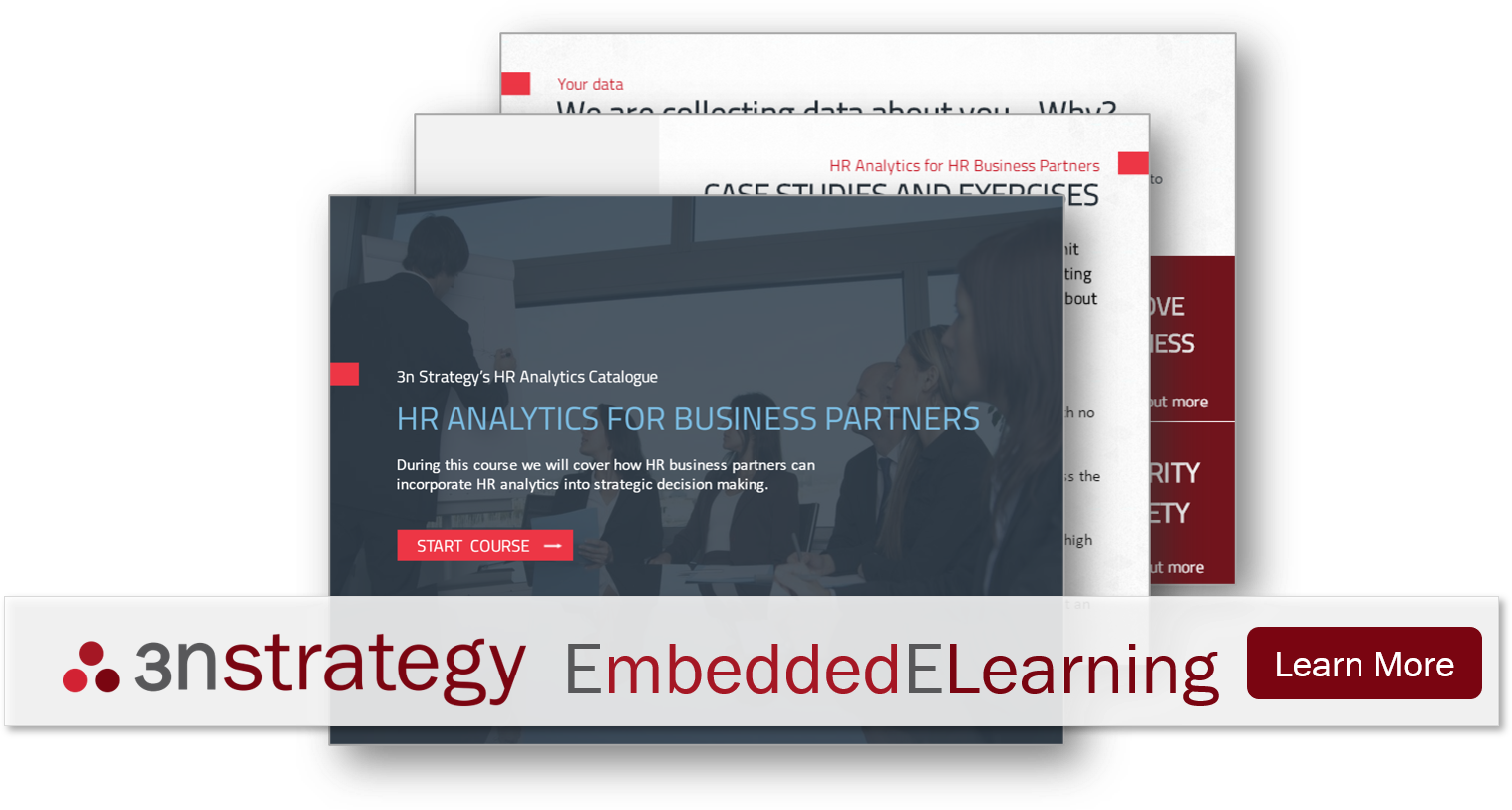Achieving success with HR and people analytics requires more than implementing a beautiful HR analytics dashboard or producing a clever report based on data science. According to the HR Analytics ThinkTank, if your internal customers have a better understanding and expectation of why they are receiving your insights, your function is over 4 times as likely to create 'strategic' value with HR analytics.
Does this scenario sound familiar to you?
- You have convinced your organisation to invest in HR analytics to improve people decision-making.
- You have built a team, bought some tools, and have begun to produce 'insights', which you are sharing with your internal customers.
- But decision making does not seem to be improving. In fact, it seems like decisions are still being made in the old way?
As analytics professionals (HR or otherwise) we are all haunted by stories where our insights were not used, and better decisions were not made. Sometimes it cannot be helped - some decision-makers will ignore the evidence no matter what. Having said that, there are often times where People and HR analytics teams increase their risk of failure by not investing in the right change management and adoption strategies, meaning HR remains not data-driven.
What is "Data Driven HR"?
In our Definitive Guide to HR Analytics we define HR analytics as:
HR and people analytics is the practice of producing and using evidence (in the form of data and analytics) to increase the likelihood that a better decision is made about the workforce.
When we talk about 'Data Driven HR', we focus on that concept: "Using Evidence". As HR analysts, it is possible for us to produce a wide variety of analytical insights to help a decision-maker choose a better action. However, if the decision-maker does or (or cannot) use the data, HR will continue to not be "data driven".
For HR to be "data driven", it needs to do more than build an analytics function - it needs to help the organisation adopt a more evidence-based approach to the way HR decisions are made.
Where does Adoption and Change Management fit into our HR Analytics strategy?
We recommend that our customers include Change Management in their business cases and strategies from the very start of their planning. Whilst many organisations choose to make fashionable milestone investments first, such as buying a new tool or hiring data scientists, an organisation that fails to plan it's adoption and enablement approach is significantly more likely to struggle to achieve success.
What change management can we do to improve the adoption of Data Driven HR?
When planning adoption, we plan how to start (and accelerate) our initial adoption and how to sustain it over time. The sustainability of adoption is important as it is common to find organisations that invest in short-term adoption activities, but fail to embed and sustain the change and therefore adoption levels drop down to previous levels over time.
When you have the right level of adoption, the right decision-makers will be aware and expect to experience the right evidence, at the right time, to help them make a better choice. When planning your adoption we recommend considering these five factors.
Data Driven HR Factor 1: Have we picked the right decisions and decision-makers?
To engage a decision-maker, we need to really understand the decision they are trying to make. We need to not only understand the context of the decision, but to understand the choice that they are responsible for making.
This may sound easy, but consider that the average enterprise HR function makes thousands of decisions across hundreds of HR processes each day. The way these decisions are made will directly impact how successful the HR function is, how effective their workforce is at doing business and how their employees experience their careers. When considering your People and HR Analytics strategy in general, we highly recommend exposing and exploring your organisations HR decision architecture.

By understanding what a decision-maker is really responsible for choosing, at any stage of an HR process, it will be easier to deliver them the evidence that makes the biggest difference for them.
Data Driven HR Factor 2: Have we set the right expectations?
As mentioned above, context plays a big role in analytics. It is important not only to understand the context of the analytics, but the context within which the decision-maker is receiving analytics.
The most commonly accepted change management frameworks emphasise the importance of communication and creating an awareness. In general, if a target population does not understand what change is expected of them, nor why, it is much harder to get the traction you want. When it comes to driving the adoption of data-driven HR practices, it is no different: According to the HR Analytics ThinkTank research, HR analytics functions that felt their decision-makers understood what to expect of analytics were 4x as likely to create more strategic value with HR analytics.
When we are planning the roll out of our Accelerator adoption strategies, we pay close attention to our comms strategy. What messages should different decision-makers receive? Why are we trying to help them make better decisions and how? Should different populations experience different types of campaigns?
Data Driven HR Factor 3: Are we choosing to share the right evidence?
Evidence is only evidence if it helps the decision-maker to make a better choice. If the evidence you use stops the decision-maker from making a decision, i.e. they start to ask about definitions or the data, then your risk of failure is already increasing.
There are many different ways to decide what type of evidence to present your decision-maker with - and experience and training are the best way of learning. What HR metric will help the decision-maker the most? What type of comparison points should you use - time, location, organisation structure? Should you use benchmarks? Should you use 'descriptive', 'diagnostic', 'predictive' or even 'prescriptive' data?
A final way to consider HR evidence is by it's functional type. The HR Analytics ThinkTank data (2020 Benchmark Data Set) looked at the types of HR data being analysed by functions around the world. Different types of HR data often represent different levels of complexity (in terms of data and skill requirements). When decided what evidence to share with decision-makers the complexity of the data is a key consideration.

Data Driven HR Factor 4: Is the decision-maker enabled and able?
To build a successful HR analytics functions, there is a variety of HR Analytics Training that you will need to consider investing in. When considering the skills sets of your decision-makers, there are two components to consider:
- Analytical Skills. In order to use the evidence they are being provided, your decision-makers need to understand the numbers presented to them. The exact level of analytical competency will vary by role - line managers will usually be presented with basic evidence and therefore only need a basic analytical skill set. Roles that are more strategic, for example HR Business Partners, will probably need a more comprehensive analytical skill set - the exact level will need to be determined by your business (in partnership with the Head of HRBPs).
- Behavioural Competency. There is not much reason making evidence available if the decision-makers forget that it exists. It is necessary to train your decision-makers to have the right habits around using evidence.
There are many ways to deliver both styles of training, from group training to public workshops (check out our workshop catalogue here). Analytical skills are usually easier to train as they are more binary in their objective - participants need support to learn types of data and analytical components. This training is often more easily scaled and applied to wider groups of employees.
Behavioural training is often trickier, requiring the training materials to more accurately reflect the job, and sometimes even the specific culture of the role and the way it works within your organisation. To create a balance of analytical and behavioural training, as part of our Accelerate programmes we use customisation eLearning catalogues that embed the analytical and behavioural traits we want to see in a user group (sometimes linked to our of our technology partners).
Data Driven HR Factor 5: Are we creating the best experience?
Your HR analytics function probably has a variety of skill sets and tools that can be used to create different types of evidence experiences for decision-makers. Perhaps your function can create different types of reports and presentations to communicate insights or you have access to different types of people and HR analytics tools that allow the creation of dashboards and reports.
Whether you are creating dashboards or writing reports it is important to remember that how decision-makers experience evidence is almost as important as the evidence itself. In reports, this will be reflected in the tone of your writing and how you position your insights.
For functions that use people and HR analytics tools, we cannot stress how important role-based permissioning (RBP) is to success. Good RBP decision will consider how many metrics a user has access to, how flexible or static the tool is, and even how many clicks it takes to access the evidence. Our Accelerator programmes for our partner vendors include time dedicate to role strategy, ensuring that roles are continually maintained to maximise evidence-based decision-making in our customers' organisations.
How do we sustain the adoption of Data Driven HR?
It can be easy to invest in one-off adoption activities. It is easy to run a workshop or send a short email campaign or design a dashboard. However over time, if the new behaviours and knowledge are not embedded into day-to-day activities, your internal customers will often revert back to old habits.
Sustaining a culture of data-driven HR takes a more dedicated approach. One of the reasons that functions who have a more knowledgeable stakeholder are nearly 8x as likely to create strategic HR analytics value is partly because they are empowered to not only drive change, but sustain it too.
There are many ways to sustain the change above, but here a few more to help you think:
- Ongoing Communication Campaigns. An obvious and easy way to sustain engagement is to maintain an ongoing communication campaign, reminding decision-makers about the evidence available to them, and sustaining their new knowledge and habits.
- Success Stories. When you can, try to find internal success stories to share with the rest of your organisation. Nothing sustains change like positive stories.
- Champions. A classic change management tactic is to use champions to spread the word. Preferably these advocates will be volunteers, and well networked within their role or org unit.
- Onboarding. When people leave the team, they take the knowledge they have with them. We recommend adding some analytics training and messaging (such as our eLearning courses) to their onboarding curriculum. This means that anyone joining the team should have a minimum level of knowledge and an expectation to use analytics in their role.
- Role Specifications. Often the hardest to change as it requires a larger remit, is to encourage the adaptation of the formal job role itself. For example, adapting the job description of an HR Business Partner to include more data-driven criteria will go a long way to embedding a culture of data driven HR in the long term.
How do we measure, track and target the adoption of Data Drive HR?
We are going to cover this in a separate, dedicated blog. To stay up to date with our blogs and webinars, please sign up to the newsletter.
.png?width=2433&height=555&name=3n%20Strategy%20PNG%20Logo%20(Transparent).png)







